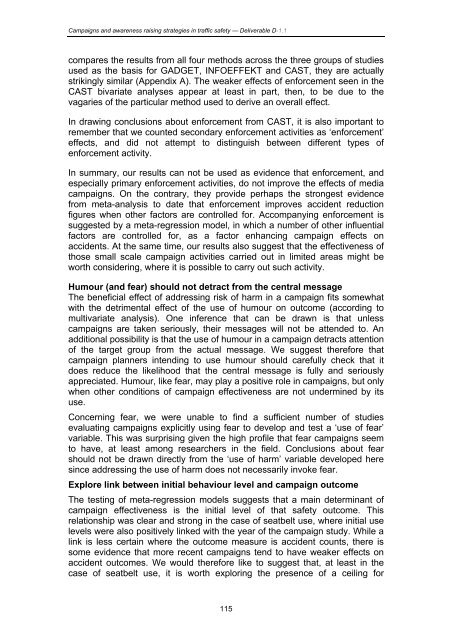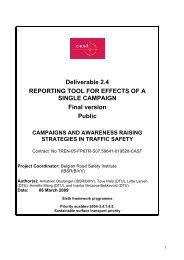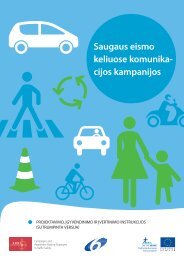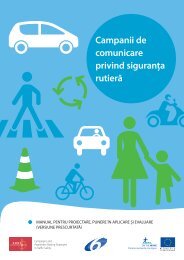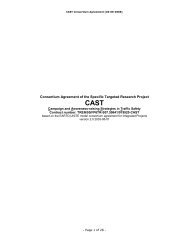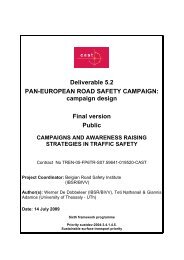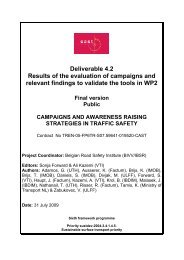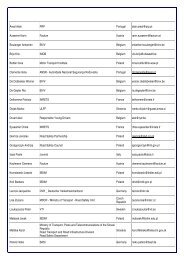Deliverable D 1.3 RESULTS OF META-ANALYSIS ... - cast-eu.org
Deliverable D 1.3 RESULTS OF META-ANALYSIS ... - cast-eu.org
Deliverable D 1.3 RESULTS OF META-ANALYSIS ... - cast-eu.org
Create successful ePaper yourself
Turn your PDF publications into a flip-book with our unique Google optimized e-Paper software.
Campaigns and awareness raising strategies in traffic safety — <strong>Deliverable</strong> D-1.1compares the results from all four methods across the three groups of studiesused as the basis for GADGET, INFOEFFEKT and CAST, they are actuallystrikingly similar (Appendix A). The weaker effects of enforcement seen in theCAST bivariate analyses appear at least in part, then, to be due to thevagaries of the particular method used to derive an overall effect.In drawing conclusions about enforcement from CAST, it is also important toremember that we counted secondary enforcement activities as ‘enforcement’effects, and did not attempt to distinguish between different types ofenforcement activity.In summary, our results can not be used as evidence that enforcement, andespecially primary enforcement activities, do not improve the effects of mediacampaigns. On the contrary, they provide perhaps the strongest evidencefrom meta-analysis to date that enforcement improves accident reductionfigures when other factors are controlled for. Accompanying enforcement issuggested by a meta-regression model, in which a number of other influentialfactors are controlled for, as a factor enhancing campaign effects onaccidents. At the same time, our results also suggest that the effectiveness ofthose small scale campaign activities carried out in limited areas might beworth considering, where it is possible to carry out such activity.Humour (and fear) should not detract from the central messageThe beneficial effect of addressing risk of harm in a campaign fits somewhatwith the detrimental effect of the use of humour on outcome (according tomultivariate analysis). One inference that can be drawn is that unlesscampaigns are taken seriously, their messages will not be attended to. Anadditional possibility is that the use of humour in a campaign detracts attentionof the target group from the actual message. We suggest therefore thatcampaign planners intending to use humour should carefully check that itdoes reduce the likelihood that the central message is fully and seriouslyappreciated. Humour, like fear, may play a positive role in campaigns, but onlywhen other conditions of campaign effectiveness are not undermined by itsuse.Concerning fear, we were unable to find a sufficient number of studiesevaluating campaigns explicitly using fear to develop and test a ‘use of fear’variable. This was surprising given the high profile that fear campaigns seemto have, at least among researchers in the field. Conclusions about fearshould not be drawn directly from the ‘use of harm’ variable developed heresince addressing the use of harm does not necessarily invoke fear.Explore link between initial behaviour level and campaign outcomeThe testing of meta-regression models suggests that a main determinant ofcampaign effectiveness is the initial level of that safety outcome. Thisrelationship was clear and strong in the case of seatbelt use, where initial uselevels were also positively linked with the year of the campaign study. While alink is less certain where the outcome measure is accident counts, there issome evidence that more recent campaigns tend to have weaker effects onaccident outcomes. We would therefore like to suggest that, at least in thecase of seatbelt use, it is worth exploring the presence of a ceiling for115


